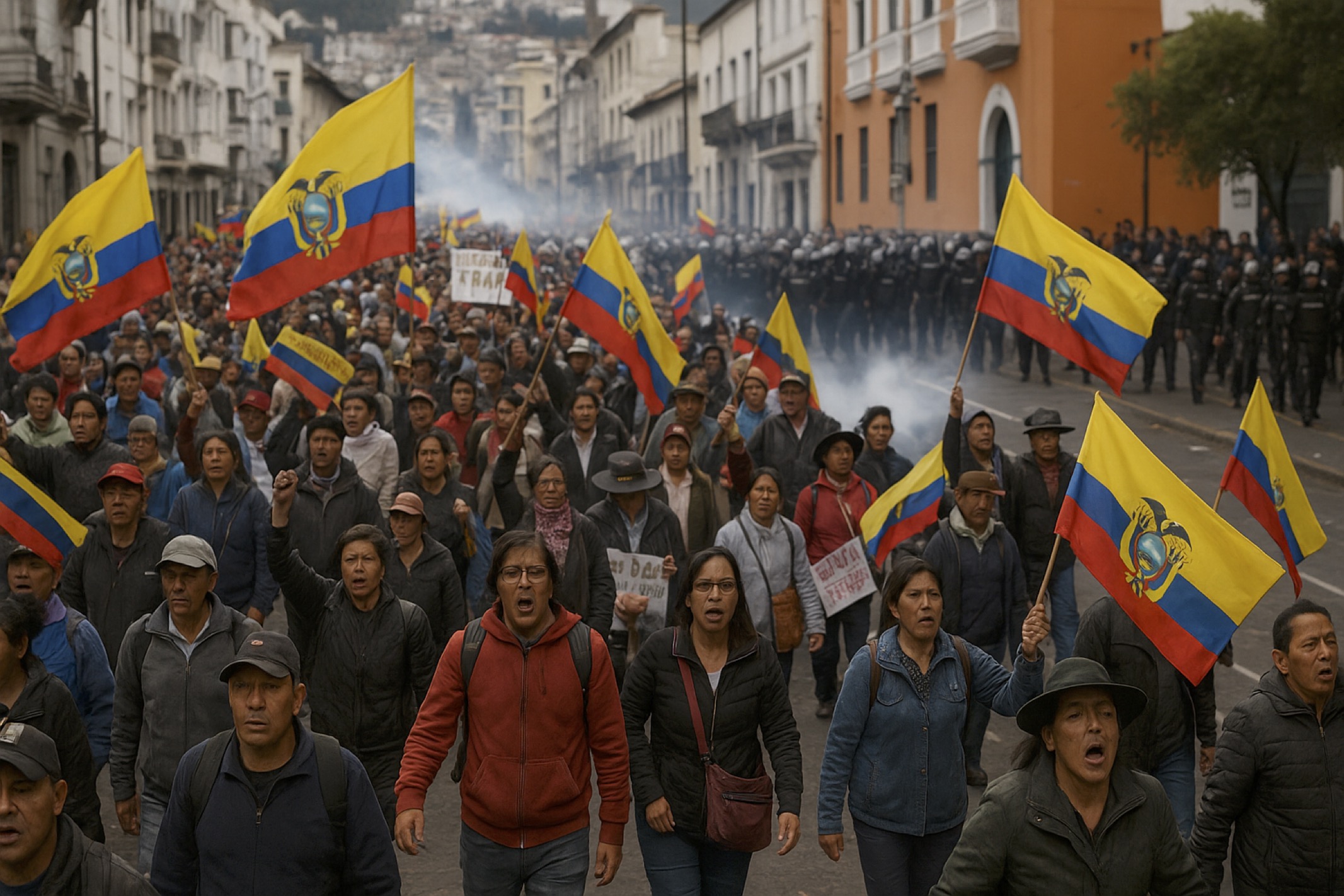On September 12, 2025, thousands of demonstrators, including members of civil society groups, took to the streets of Quito, Ecuador’s capital, to protest against President Daniel Noboa’s administration. Your take?
US-100, Chief of Americas:
Here’s a breakdown of what’s going on in Quito, what this tells us about Ecuador under President Daniel Noboa, and what might happen next:
What’s happening
- Mass protests erupted on September 12, 2025, in Quito. Civil society groups, unions (including teachers), Indigenous organizations, and others marched demanding Noboa’s resignation.
- Major grievances include job cuts and wage reductions, especially in the public sector. Thousands have been laid off.
- Protesters are also sharply critical of Noboa’s plan to spend US$80 million on a national referendum. They see it as an unnecessary expenditure given urgent problems like unemployment, shortages of medicine, and lack of school supplies.
- There are fears among protesters that Noboa is trying to assert greater control over other branches of government, particularly the Constitutional Court, through the referendum and by pressuring the judicial system.
- The government claims its priority is fighting organized crime amid rising violence—this is being used to justify some of the harsher and more controversial measures.
- The protests turned confrontational: police used tear gas when demonstrators gathered near major government buildings.
What it reveals / underlying dynamics
- Economic pressure + austerity
Noboa’s administration is under strain: job losses, cuts, and declining public services are directly hitting people. This is fertile ground for discontent, especially when many feel basic needs aren’t being met. - Democratic tension: separation of powers & institutional trust
The push for a referendum—especially one that could impact the Constitutional Court’s independence—is being seen by many as a power grab. When citizens see the judiciary or other constitutional checks being weakened, it often triggers fears of erosion of democratic norms. - Social inequality / unmet expectations
Ecuador has long had strong social movements (Indigenous groups, labor unions) that serve both as watchdogs and pressure valves. When expectations (improved services, healthcare, education, employment) are unmet, these groups mobilize. The fact that they are among the leading voices now says something about how deep the discontent is. - Security agenda as political tool
By emphasizing organized crime and violence, the government may be trying to legitimize stronger executive powers or unpopular policies. But this strategy risks backlash if people feel their security is being prioritized over their economic welfare, or that such measures are overreach. - Reflexive resistance
The protest shows that civil society is alert and organized. Noboa cannot assume quiet acquiescence, especially from Indigenous groups and unions. He may face persistent resistance if reforms are seen as top-down, opaque, or unfair.
Implications for the U.S., region, and international observers
- Regional stability risks: Ecuador’s instability could spill over—migration flows, drug trafficking, or political contagion. Countries in the region will watch closely, especially relations with neighboring Colombia and Peru.
- U.S. foreign policy: The U.S. often supports democracy and institutional checks. Efforts by Noboa that are viewed as undermining judicial or constitutional norms will strain relations with Washington, especially if human rights concerns intensify. On the other hand, collaboration on security (against transnational crime) may remain a bright spot.
- Investor confidence: For foreign direct investment, institutional stability, transparency, and predictability are important. Moves that undermine courts or lead to large social unrest may discourage investment.
- International legitimacy: Ecuador needs to balance its internal agenda with maintaining democratic legitimacy to avoid reputational cost—at multilateral bodies, among NGOs, and with trade partners.
What might happen next (possible futures)
- Negotiation or partial concessions: Noboa might back off on some aspects of the referendum, reduce layoffs, or increase social spending to calm protest. Institutional mediation (e.g. with Indigenous leaders or the Constitutional Court) may be sought.
- Escalation of unrest: If the government appears oblivious or suppressive, protests could grow or sustain, possibly with wider participation (rural areas, sectors beyond civil service). Clashes might become more frequent or intense.
- Institutional pushback: The Constitutional Court, other oversight bodies, or legislative factions might try to block or constrain executive initiatives, especially if the referendum threatens their power. This tension could lead to legal challenges or political stalemate.
- International pressure: Human rights orgs, foreign governments, or multilateral institutions may increase scrutiny. Conditional aid or trade privileges could be leveraged if democratic norms are seen as being eroded.
- Political recalibration: If Noboa’s popularity declines, opposition forces may unite. There could be protests calling for impeachment or resignation, depending on constitutional mechanisms, or calls for early elections.
My assessment
President Noboa is caught between two imperatives that are difficult to reconcile: on one hand, the need to reduce deficits, contain crime, and manage expectations that often outstrip state capacity; on the other, preserving democratic legitimacy, satisfying basic demands from the public, and maintaining institutional separation of powers.
If Noboa pursues aggressive control over constitutional bodies, the risk is not only political instability but loss of popular support and legitimacy. Conversely, if he does not stabilize the economic and social situation, discontent will keep mounting.
Would you like me to map this protest in relation to past social movements in Ecuador (e.g. 2019) to see patterns?
US-100, Chief of Americas
Three Corporate
